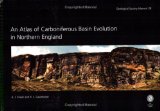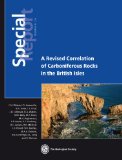Carboniferous
- 1Up Info Carboniferous period (Geology And Oceanography) - Encyclopedia
- A Carboniferous
- A lithostratigraphical framework for the Carboniferous successions of southern Great Britain (onshore)

- A Revised Correlation of the Cambrian Rocks in the British Isles - Biostratigraphical divisions

- A Visit To The Early Cambrian Waucoba Spring Geologic Section, California
- Biostratigraphy, sequence stratigraphy and gamma-ray spectrometry of the Tournaisian-Viséan boundary interval in the Dublin Basin

- Bivalves and brachiopods in the Carboniferous - Early Permian of Argentine Precordillera: Diversification and faunal turnover in Southwestern Gondwana

- Carbonifer
- Carboniferous
- Carboniferous of the Netherlands and surrounding areas; a basin analysis

- Carboniferous Period
- Carboniferous Period
- Carboniferous Period
- Carboniferous Period of the Paleozoic Era
- Castle Conglomerate Unit of the Upper Silesian Basin (Czech Republic and Poland): a record of the onset of Late Mississippian C2 glaciation?

- Conditions of accumulation and sedimentary architecture of the upper Westphalian Cracow Sandstone Series (Upper Silesia Coal Basin, Poland)

- Correlation potential of magnetic susceptibility and outcrop gamma-ray logs at Tournaisian-Viséan boundary sections in western Europe

- Discovery of a Mississippian Reef in Turkey: The Upper Viséan Microbial-Sponge-Bryozoan-Coral Bioherm From Kongul Yayla (Taurides, S Turkey)

- Earliest Carboniferous tetrapod and arthropod faunas from Scotland populate Romer’s Gap

- Early Carboniferous biogeographic position of the Balkan Peninsula

- Exceptionally preserved crustaceans from western Canada reveal a cryptic Cambrian radiation

- High resolution biostratigraphy of the Tournaisian-Viséan boundary interval in the North Staffordshire Basin and correlation with the South Wales-Mendip Shelf

- Lacustrine couplet-lamination: evidence for Late Pennsylvanian seasonality in central equatorial Pangaea (Stephanian B, Mšec Member, Central and Western Bohemian basins)

- Lower and middle Cambrian of Sweden: trilobites, biostratigraphy and intercontinental correlation

- Lower Carboniferous (Late Visean) platform development and cyclicity in southern Ireland: foraminiferal biofacies and lithofacies evidence

- Lower Carboniferous (Mississippian) stratigraphy of northwestern Poland: conodont, miospore and ostracod zones compared

- Lower Carboniferous carbon isotope stratigraphy in South China: Implications for the Late Paleozoic glaciation

- Magnetic Characteristics of Carboniferous Continental Depositional Systems: Implications for the Recognition of Depositional Hiatuses

- Microbial life in the late Paleozoic: new discoveries from the Early Devonian and Carboniferous

- Microfacies and palaeoenvironments of the Lower Carboniferous Mobarak Formation in the Kiyasar section, Northern Iran

- Microfossils from the Mississippian - Redwall and Escabrosa Limestones
- Mississippian Fossils of Missouri
- National Comission for Stratigraphy of Belgium - Subcommission Carboniferous
- New interpretations of the Carboniferous stratigraphy of SW Poland based on miospore data

- Palynology and correlation of Carboniferous-Permian glacigene rocks in Oman, Yemen and Pakistan

- Pennsylvanian Fossils of Missouri - Lake Neosho Shale
- Post-Variscan (end Carboniferous-Early Permian) basin evolution in Western and Central Europe

- Refinements in biostratigraphy of the foraminiferal zone MFZ11 (late early Viséan, Mississippian) in the Cebeciköy Limestone (İstanbul Terrane, NW Turkey) and palaeogeographic implications

- Remnants of Early Carboniferous I-type granodiorite plutons in the Bavarian Forest and their bearing on the tectonic interpretation of the south-western sector of the Bohemian Massif (Bavarian Zone)

- Sedimentology and magnetic susceptibility of Mississippian (Tournaisian) carbonate sections in Belgium

- Sequence stratigraphy of Carboniferous paralic deposits in the Lublin Basin (SE Poland)

- Stratigraphy of the Carboniferous
- XIV International Congress on the Carboniferous and Permian
- XVII International Congress on the Carboniferous and Permian - Perth, Australia, July 3-8 2011
Books about Carboniferous
| Atlas of Carboniferous Basin Evolution Why an atlas of the Carboniferous in northern England? There can hardly be a more researched system in the whole of the British Isles, given its widespread distribution at outcrop and annual appearances in numerous PhD theses (including those of the authors). But perhaps all we really know about the Carboniferous is no more than skimming the surface. In this atlas, using modern multifold seismic and borehole data collected by the oil industry in its search for petroleum accumulations, we can start to look beyond the surface exposures and gain some new insights into the structure and stratigraphy of the subsurface (and surface) Carboniferous. The unique appeal of this atlas of seismic sections is that it is based on data from onshore UK. Although these lines were originally shot as small segments targeting individual prospects and trends, they have been spliced together to produce a series of basin-scale regional lines which should be of value to academic researchers and industry alike. With this atlas, we can walk the seismic lines at outcrop and in many cases compare exposure to both the seismic data and associated palaeofacies maps. |
|
| Permo-Carboniferous Magmatism And Rifting in Europe Widespread extension occurred within the Variscan orogen and its northern foreland during Late Carboniferous to Early Permian times. This was associated with magmatism and with a fundamental change, at the Westphalian-Stephanian boundary, in the regional stress field, coincident with the termination of orogenic activity and onset of dextral translation between North Africa and Europe. Rifting propagated across basement terranes with different ages and thermal histories. Most of the rift basins developed on relatively thin lithosphere; however, the highly magmatic Oslo Graben initiated within the edge of a craton. Early Stephanian regional uplift is contemporaneous with the onset of magmatism, inviting speculation that it might have been induced by a thermal anomaly within the upper mantle. The contributions to this volume suggest that the geodynamic setting in which magmatism occurred was complex, involving wrench tectonics, slab detachment, and delamination or thermal erosion of the base of the lithosphere. |
|
| Proceedings of the XVth International Congress on Carboniferous and Permian Stratigraphy: Utrecht, 10-16 August 2003 A compendium of papers first presented at the fifteenth annual International Congress on Carboniferous and Permian Stratigraphy, this book offers an overview of the latest research on rock formation that took place over 250 million years ago. This ancient sediment, which provides much of the mineral resources we use today, is a key indicator of massive environmental shifts that occurred around the creation of the super-continent Pangea. Organized thematically, the book covers a wide variety of topics, including the structural development of Carboniferous basins, the paleontology of those periods, and Carboniferous and Permian timescales and global correlations. As the contributors demonstrate, a better understanding of the evolution of the earth during the Carboniferous and Permian periods will not only help us find more mineral resources, but will also provide insight into important modern environmental questions. |
|
| A Bibliographic Index of North American Carboniferous Invertebrates This is an EXACT reproduction of a book published before 1923. This IS NOT an OCR'd book with strange characters, introduced typographical errors, and jumbled words. This book may have occasional imperfections such as missing or blurred pages, poor pictures, errant marks, etc. that were either part of the original artifact, or were introduced by the scanning process. We believe this work is culturally important, and despite the imperfections, have elected to bring it back into print as part of our continuing commitment to the preservation of printed works worldwide. We appreciate your understanding of the imperfections in the preservation process, and hope you enjoy this valuable book. |
|
| A Revised Correlation of Carboniferous Rocks in the British Isles This report revises and expands upon the 1976 and 1978 publications for the Dinantian and Silesian, respectively, combining them into a single account of British and Irish Carboniferous stratigraphy. The need to update the two Special Reports reflects the considerable advances in Carboniferous geology over the last 30 years. The report covers developments in international chronostratigraphy and incorporates wholesale reassessments of British lithostratigraphy. A huge volume of biostratigraphical information has been published over recent decades and the report summarizes the key information. Carboniferous rocks have long been of economic importance, but it is the search for hydrocarbons, in its infancy at the time of the previous reports, which has greatly increased our understanding of Carboniferous successions offshore and at depth, particularly in southern and eastern England. This Special Report will be a valuable reference for research and applied geoscientists working on rocks of Carboniferous age in the UK, Ireland and offshore areas. |
|
| Recent Advances in Lower Carboniferous Geology Rocks of Lower Carboniferous age are widely developed across Europe. Apart from their instrinsic geological interest, they are hosts to major Zn-Pb-Cu-Ba deposits in Ireland and Au-FeS2 deposits in the Iberian Pyrite Belt. Further, the Upper Palaeozoic rocks of Europe are increasingly becoming the target of oil and gas exploration. The wealth of data on Lower Carboniferous rocks,while not guaranteeing success, will be an invaluable tool for exploration, This book brings together in one volume advances over the last decade in several specialist subdisciplines of geology. It contains papers on carbonate and clastic sedimentology, palaeontology, palaeoecology, stratigraphy and biostratigraphy. |





